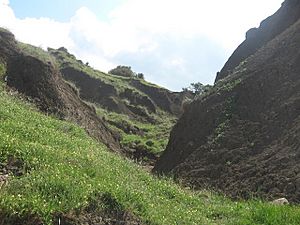Sheppey Cliffs and Foreshore facts for kids
| Site of Special Scientific Interest | |

Barrow Brook Valley
|
|
| Area of Search | Kent |
|---|---|
| Interest | Biological Geological |
| Area | 303.6 hectares (750 acres) |
| Notification | 1998 |
| Location map | Magic Map |
Sheppey Cliffs and Foreshore is a very special area in Kent, England. It stretches between the towns of Minster and Leysdown-on-Sea. This amazing place is a Site of Special Scientific Interest (SSSI). It's important for both its unique plants and animals (biological) and its ancient rocks and fossils (geological).
The site covers about 303.6 hectares (750 acres), which is like 750 football fields! Scientists have been studying the fossils here since the 1700s. You can find well-preserved fossils of plants and animals from the Eocene period. These fossils are found in a type of rock called London Clay.
Contents
Discovering Sheppey's Ancient Past
The London Clay found at Sheppey Cliffs was formed a very long time ago. It was laid down in a shallow sea. Some of these clay layers can be up to 200 metres (660 ft) thick! Scientists have found up to five different layers of clay. Each layer shows a time when the sea got shallower.
Layers of Time: What the Clay Tells Us
Each cycle of clay deposition started with rougher material. Then, finer clay was laid down. This clay became sandier over time. These layers are named A to E, with A being the oldest. At Sheppey, you can see layers C, D, and E. Each layer has its own unique plants and animals.
Amazing Fossils: Life from the Eocene Sea
The fossils found here are incredibly well-preserved. You can find many types of invertebrates. These include bivalves (like clams) and gastropods (like snails). There are also brachiopods and nautiloids. Sometimes, you can even find whole lobsters, crabs, and insects!
Many fossils of ancient sharks, rays, and bony fish have been found. You can also discover bones from reptiles and birds. Some bones are found inside hard lumps in the clay. Many have also washed out onto the beach. Reptiles found here include turtles, crocodiles, and snakes. Scientists have identified birds from sixteen different families!
Ancient Plants: Sheppey's Fossil Forest
Sheppey Cliffs is also a fantastic place for studying ancient plants. This is called palaeobotany. Many fossils of Eocene plants have been found. Most of these come from layers D and E. Over 300 different plant species have been recorded!
Many of the plants found are tropical lianas. These are like woody vines that grow in jungles. It seems that this area was once a lush forest. This forest grew right next to a warm, shallow sea.
Unique Plants and Wildlife
This site is very important for its plant life. One special plant found here is the dragon's teeth (Tetragonolobus maritimus). This plant is very rare in Britain. It grows in only a few places.
Another uncommon plant found at Sheppey is the bithynian vetch (Vicia bithynica). These rare plants make the Sheppey Cliffs and Foreshore a truly special place. It's important to protect this area for its amazing natural history.

